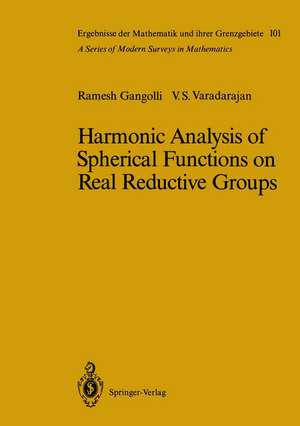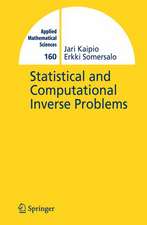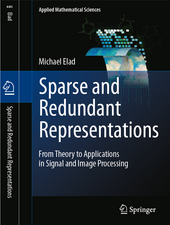Harmonic Analysis of Spherical Functions on Real Reductive Groups: ERGEBNISSE DER MATHEMATIK UND IHRER GRENZGEBIETE 2 FOLGE, cartea 101
Autor Ramesh Gangolli, Veeravalli S. Varadarajanen Limba Engleză Paperback – 16 dec 2011
Din seria ERGEBNISSE DER MATHEMATIK UND IHRER GRENZGEBIETE 2 FOLGE
-
 Preț: 442.02 lei
Preț: 442.02 lei -
 Preț: 409.43 lei
Preț: 409.43 lei -
 Preț: 484.47 lei
Preț: 484.47 lei -
 Preț: 376.96 lei
Preț: 376.96 lei -
 Preț: 491.72 lei
Preț: 491.72 lei -
 Preț: 345.71 lei
Preț: 345.71 lei -
 Preț: 383.12 lei
Preț: 383.12 lei -
 Preț: 382.95 lei
Preț: 382.95 lei - 15%
 Preț: 636.45 lei
Preț: 636.45 lei -
 Preț: 489.87 lei
Preț: 489.87 lei -
 Preț: 387.75 lei
Preț: 387.75 lei - 15%
 Preț: 493.56 lei
Preț: 493.56 lei -
 Preț: 393.35 lei
Preț: 393.35 lei -
 Preț: 377.95 lei
Preț: 377.95 lei -
 Preț: 384.31 lei
Preț: 384.31 lei -
 Preț: 413.07 lei
Preț: 413.07 lei -
 Preț: 380.25 lei
Preț: 380.25 lei -
 Preț: 412.68 lei
Preț: 412.68 lei -
 Preț: 385.62 lei
Preț: 385.62 lei -
 Preț: 415.39 lei
Preț: 415.39 lei -
 Preț: 376.59 lei
Preț: 376.59 lei -
 Preț: 379.48 lei
Preț: 379.48 lei -
 Preț: 483.27 lei
Preț: 483.27 lei -
 Preț: 414.42 lei
Preț: 414.42 lei - 15%
 Preț: 579.67 lei
Preț: 579.67 lei - 15%
 Preț: 636.63 lei
Preț: 636.63 lei -
 Preț: 419.06 lei
Preț: 419.06 lei - 18%
 Preț: 1108.67 lei
Preț: 1108.67 lei - 15%
 Preț: 578.37 lei
Preț: 578.37 lei -
 Preț: 381.43 lei
Preț: 381.43 lei -
 Preț: 383.12 lei
Preț: 383.12 lei -
 Preț: 375.45 lei
Preț: 375.45 lei -
 Preț: 171.74 lei
Preț: 171.74 lei -
 Preț: 150.03 lei
Preț: 150.03 lei -
 Preț: 381.00 lei
Preț: 381.00 lei -
 Preț: 413.27 lei
Preț: 413.27 lei -
 Preț: 410.17 lei
Preț: 410.17 lei -
 Preț: 381.21 lei
Preț: 381.21 lei -
 Preț: 383.12 lei
Preț: 383.12 lei -
 Preț: 480.83 lei
Preț: 480.83 lei -
 Preț: 375.62 lei
Preț: 375.62 lei -
 Preț: 382.36 lei
Preț: 382.36 lei -
 Preț: 383.50 lei
Preț: 383.50 lei -
 Preț: 181.74 lei
Preț: 181.74 lei -
 Preț: 408.77 lei
Preț: 408.77 lei -
 Preț: 359.54 lei
Preț: 359.54 lei -
 Preț: 376.43 lei
Preț: 376.43 lei
Preț: 704.04 lei
Preț vechi: 828.27 lei
-15% Nou
Puncte Express: 1056
Preț estimativ în valută:
134.72€ • 138.98$ • 112.42£
134.72€ • 138.98$ • 112.42£
Carte tipărită la comandă
Livrare economică 27 martie-10 aprilie
Preluare comenzi: 021 569.72.76
Specificații
ISBN-13: 9783642729584
ISBN-10: 3642729584
Pagini: 388
Ilustrații: XIV, 365 p.
Dimensiuni: 170 x 242 x 20 mm
Greutate: 0.62 kg
Ediția:Softcover reprint of the original 1st ed. 1988
Editura: Springer Berlin, Heidelberg
Colecția Springer
Seria ERGEBNISSE DER MATHEMATIK UND IHRER GRENZGEBIETE 2 FOLGE
Locul publicării:Berlin, Heidelberg, Germany
ISBN-10: 3642729584
Pagini: 388
Ilustrații: XIV, 365 p.
Dimensiuni: 170 x 242 x 20 mm
Greutate: 0.62 kg
Ediția:Softcover reprint of the original 1st ed. 1988
Editura: Springer Berlin, Heidelberg
Colecția Springer
Seria ERGEBNISSE DER MATHEMATIK UND IHRER GRENZGEBIETE 2 FOLGE
Locul publicării:Berlin, Heidelberg, Germany
Public țintă
ResearchCuprins
1. The Concept of a Spherical Function.- § 1.1. Review of Some Basic Notions of Representation Theory.- § 1.2. Decomposition of a Representation with Respect to a Compact Subgroup K and K-finite Representations.- § 1.3. Elementary Spherical Functions of Arbitrary Type.- § 1.4. Spherical Functions on Lie Groups.- § 1.5. Gel’fand Pairs (G, K).- § 1.6. Plancherel Formula for G/K.- § 1.7. Eigenfunction Expansions in G/K.- Notes on Chapter 1.- 2. Structure of Semisimple Lie Groups and Differential Operators on Them.- § 2.1. Groups of Class ?.- § 2.2. Iwasawa Decomposition. Roots. Weyl Group.- § 2.3. Parabolic Subalgebras and Parabolic Subgroups.- § 2.4. Integral Formulae.- § 2.5. Flag Manifolds, Bruhat Decomposition and Related Integral Formulae.- § 2.6. Differential Operators on G and G/K.- Notes on Chapter 2.- 3. The Elementary Spherical Functions.- § 3.1. Principal Series Representations and Integral Representations for Their Matrix Coefficients.- § 3.2. Determination of All Elementary Spherical Functions. The Functional Equations.- § 3.3. The Harish-Chandra Transform.- § 3.4. Finite Dimensional Representation Theory of G and Its Consequences for the H-Function and the Elementary Spherical Functions.- § 3.5. Convexity Properties of the H-Function.- Notes on Chapter 3.- 4. The Harish-Chandra Series for ?? and the c-Function.- §4.1. Radial Components of Spherical Differential Operators on A+.- § 4.2. The Radial Component of the Casimir Operator.- § 4.3. Construction of the Eigenfunctions on G+.- § 4.4. The Harish-Chandra Series for ?? and the c-Function.- § 4.5. Estimates for the Harish-Chandra Series When ? Becomes Unbounded.- § 4.6. Estimates for the Elementary Spherical Functions. The Functions ? and ?.- § 4.7. The c-Function.- Noteson Chapter 4.- 5. Asymptotic Behaviour of Elementary Spherical Functions.- § 5.1. The Case When rk(G/K) =1.- § 5.2. The Basic Differential Equations Viewed as a Perturbation of a Linear System: The Regular Case.- § 5.3. Radial Components on M10? and M10+.- § 5.4. The Basic Differential Equations Viewed as a Perturbation of a Linear System: The General Case.- § 5.5. Spectral Theory of Representations of Polynomial Rings Associated to Finite Reflexion Groups.- § 5.6. The Initial Estimates.- § 5.7. Perturbations of Linear Systems (with A Priori Estimates).- § 5.8. Asymptotics of ?0(?:·) on M10+. The Function ?.- § 5.9. Asymptotics of ?(?:·).- § 5.10. Complements. Constant Term for Tempered ?-Finite Functions.- Notes on Chapter 5.- 6. The L2-Theory. The Harish-Chandra Transform on the Schwartz Space of G//K.- § 6.1. The Schwartz Spaces C(G) and C(G//K).- § 6.2. The Harish-Chandra Transform on C(G//K).- § 6.3. Wave Packets in C(G//K).- § 6.4. Statements of the Main Theorems.- § 6.5. The Method of Harish-Chandra.- § 6.6. The Method of Gangolli-Helgason-Rosenberg.- Notes on Chapter 6.- 7. Lp-Theory of Harish-Chandra Transform. Fourier Analysis on the Spaces Cp(G//K).- §7.1. Radial Components and Their Expansions.- § 7.2. The Differential Equations, Initial Estimates, and the Approximating Sequence.- § 7.3. Expressions for ?0 — ?n0, ?n0 — ?n-10, and Estimates for ?0 — exp(?0)?n0.- § 7.4. Further Study of the ?n0. The Matrices ?q.- § 7.5. The Functions ?q.- § 7.6. Asymptotic Expansions for ??.- § 7.7. The Tube Domains ??, *?? and the Function Spaces ?(??), ?(??).- § 7.8. The Spaces Cp(G//K).- § 7.9. Study of the Functions ?q.- § 7.10. Wave Packets and the Transform Theory for Cp(G//K).- Notes on Chapter 7.















